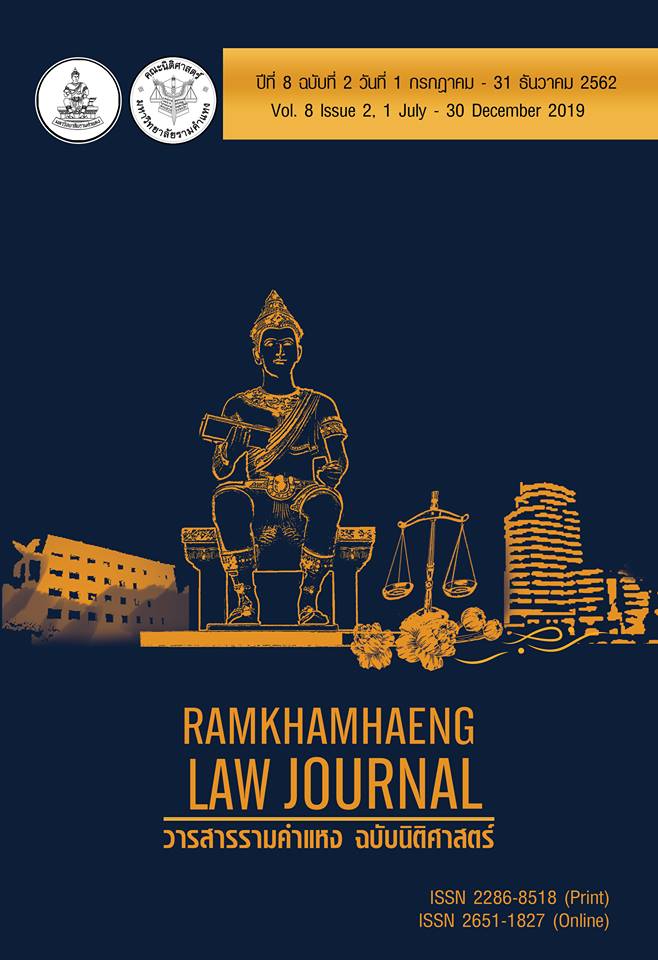การลักลอบค้าสัตว์ป่ากับองค์กรอาชญากรรมข้ามชาติ
Main Article Content
Abstract
Human beings are destroying natural resources, andmany speciesof wildlife are being threatened with extinctionas a result. It is hunting and the wildlife trade in particular that are causing wildlife populations to diminish rapidly. In 1975, the Conventionon International Trade in Endangered Species of Wild Fauna and Flora (CITES) took effect to control the international wildlife trade. The Convention established a permit system that differentiates on the basis of the conservation status of a species to provide protection for wildlife in international trade. Wildlife populations continue to decrease, however, because of the high demand for wildlife products. Transnational criminal organizations have become significant playersin wildlife trafficking due to the high profits offered by the illegal wildlife trade. These criminal enterprises possess global networks, expertise in smuggling, and access to illegal markets that have made CITES alone insufficient to effectivelyprotect wildlife from illegal international trade. It is therefore important to apply the provisions of other agreements and lawsto assist in the fight against the illegal wildlife trade. Those would include international agreements such as the United Nations Convention against Transnational Organized Crime (UNTOC), and Thai laws including the Wildlife Preservation and Protection Act, B.E. 2562, and the Prevention and Suppression of Participation in Transnational Organised Crime Act, B.E. 2556.
Article Details
References
Abotsi, Kofi Ernest. Paolo Galizzi, AlenaKerklotz, “Wildlife Crime and Degradation in Africa: An Analysis of the Current Crisis and Prospects for Secure Future.” 27Fordham Envtl. Law Rev. (Spring 2016): 394-440.
Alexandre, Kiss and Dinah Shelton. International Environmental Law, 3rd ed. UNEP, 2003.
Asner, Marcus A. “To Catch a Wildlife Thief: Strategies and Suggestions for the Fight Against Illegal Wildlife Trafficking.” 12 U. Pa. Asian L. Rev. Fall, 2016, 1-20
Campbell, Liz. Organised Crime and the Law: A Comparative Analysis. Oxford: Hart Publishing, 2013.
Elliott, Lorraine. “Transnational Environmental Crime in the Asia Pacific: an ‘un(der) securitized’ security problem” in Rob White (ed.), Environmental Crime: A Reader. Portland: Willan Publishing, 2009.
Lohanan, R. “The elephant situation in Thailand and a plea for co-operation.” in Iljas Baker and MasakasuKashio (ed.), Giants on Our Hands, Proceedings of the International Workshop on the Domesticated Asian Elephant, UN Food and Agricultural Office (FAO), 2002.
Maethinee Phassaraudomsak and Kanitha Krishnasamy, TRADING FACES A Rapid Assessment on the use of Facebook to trade wildlife in Thailand, TRAFFIC, September 2018.
Milliken, T. and Shaw, J., The South Africa – Viet Nam Rhino Horn Trade Nexus: A deadly combination of institutional lapses, corrupt wildlife industry professionals and Asian crime syndicates. Johannesburg: TRAFFIC, South Africa, 2012.
CITES [Online]. Available URL: https://cites.org/eng/disc/what.php, 2018 (June, 20).
ICCWC [Online]. Available URL: https://cites.org/eng/prog/iccwc.php, 2018 (June, 20).
CITES [Online]. Available URL: https://cites.org/eng/res/08/08-04R15.php, 2018 (June, 20).
CITES National Legislation Project, [Online]. Available URL: https://cites.org/sites/ default/files/eng/prog/Legislation/CITE_national_legislative_status_table-sep tember-2018.pdf, 2018 (June, 20).
UNTOC [Online]. Available URL: https://treaties.un.org/Pages/ViewDetails.aspx?src= ND&mtdsg_no=XVIII-12&chapter=18&lang=en, 2018 (June, 20).
Chair’s Summary of Roundtable on Combating Transnational Organized Wildlife and Forest Crime for Ministers and High-Level Representatives [Online]. Available URL: https://www.cites.org/sites/default/files/eng/cop/16/inf/E-CoP16i-54.pdf, 2018 (June, 20).
CITES [Online]. Available URL: https://www.cites.org/eng/app/appendices.php, 2018 (June, 20).
CITES Article II [Online]. Available URL: https://www.cites.org/eng/disc/text.php#III, 2018 (June, 20).
London Conference on the Illegal Wildlife Trade [Online]. Available URL: https:// www.gov.uk/government/publications/declaration-london-conference-on-the -illegal-wildlife-trade-2018/london-conference-on-the-illegal-wildlife-trade-oc tober-2018-declaration, 2019 (March, 8).
INTERPOL [Online]. Available URL: https://www.interpol.int/How-we-work/Databases/ Our-17-databases, 2019 (March, 8).
IUCN [Online]. Available URL: https://www.iucnredlist.org/about/background-history, 2019 (March, 8).
Kaziranga National Park [Online]. Available URL: https://www.kaziranga-national-park.com/ blog/rhino-poaching-crisis-conservation-assam/, 2019 (March, 8).
The Guardian Newspaper [Online]. Available URL: https://www.theguardian.com/envi ronment/2012/dec/12/wildlife-trafficking-national-security-wwf, 2019 (March, 8).
UNTOC [Online]. Available URL: https://www.unodc.org/documents/treaties/UNTOC/Publica tions/TOC%20Convention/TOCebook-e.pdf, 2018 (June, 20).
UN Secretary General [Online]. Available URL: https://www.unodc.org/pdf/crime/ commissions/12_commission/8e.pdf, 2018 (June, 20).
Reichel, Philip and Jay Albanese. (ed.). Handbook of Transnational Crime and Justice 2nd ed. California: SAGE Publications, 2014.
TRAFFIC, What’s Driving the Wildlife Trade? A Review of Expert Opinion on Economic and Social Drivers of the Wildlife Trade and Trade Control Efforts in Cambodia, Indonesia, Lao PDR and Vietnam, East Asia and Pacific Region Sustainable Development Discussions Papers, The World Bank, Washington DC, 2008.
UNODC. Criminal Justice Response to Wildlife Crime in Thailand: A Rapid Assessment. Bangkok: UNODC, 2013.
UNODC. Transnational Organized Crime in East Asia and the Pacific: A Threat Assessment. Bangkok: UNODC, 2013.
vanUhm, Daan P. “Corruption Within the Illegal Wildlife Trade: A Symbiotic and Antithetical Enterprise.” Br. J. Criminal 58 (4) (2018): 864-885.

